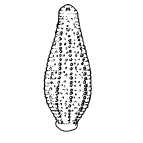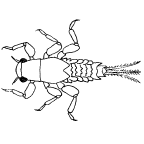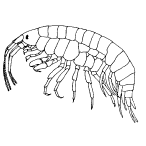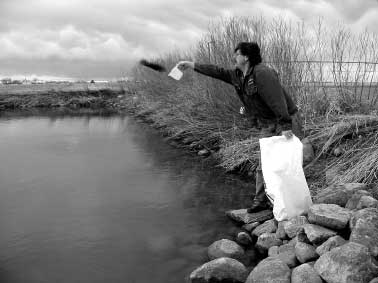| | Boosting natural foods | Nutrient requirements | Feed supply, size and storage | Feeding practices
Proper nutrition is essential to the health of all animals, and fish are no exception. Recreationally cultured fish stocked at a reasonable density in a dugout or pond will obtain most, if not all, their nutrition from their environment.
Depending on the ecology of each pond, this natural supply of food may include varied amounts of aquatic and terrestrial invertebrates, such as insects, worms, leeches and freshwater shrimp (Figure 1), as well as amphibians, minnows, plant material and microscopic plankton. However, fish that are found to be slow grow-ing, small at harvest or were knowingly more densely stocked may need to be provided with prepared feeds.
  
Figure 1. Leech, mayfly larvae and freshwater shrimp. Some possible natural aquatic feed sources visible and available to your pond fish.
Drawings from Aquatic Invertebrates of Alberta (1991) and used with the permission of the University of Alberta Press and Hugh F. Clifford.
Boosting Natural Foods
If you don't want to trouble yourself with prepared feeds but still want your fish to grow quickly, there are a number of ways to encourage nature to provide more food for your fish.
An older pond with a moderate amount of aquatic weeds and a more developed shoreline habitat will provide an environment suitable for the production of plankton, freshwater shrimp and other natural foods. You can encourage this natural pond aging process by:
- planting aquatic and shoreline vegetation
- providing artificial submerged habitat structures
- moving freshwater shrimp from a more established pond
A light placed safely near a pond has been proven to attract flying insects, a good source of free and natural fish food.
Nutrient Requirements
Fish require energy for all aspects of life, including growth, activity, osmotic balance and potential reproduction. Energy requirements for basic body functions must first be met before energy is available for any additional growth.
Fish living in cool, still water are less active and have lowered metabolic rates and food energy requirements. In general, the food energy requirements per unit weight are also less in larger, older fish than with small young fish.
If providing supplemental feed to your fish, keep in mind that a balanced diet must contain the required nutrients in proper proportions.
There are five main constituents in the diets of fish, all essential in meeting their energy and growth requirements:
- protein
- fat
- carbohydrate
- vitamins
- minerals
The natural diets of most fish are rich in protein, so prepared rations must also have a high protein content, usually between 25-40 per cent. Fats are the most concentrated energy source of the nutrient groups. In addition to supplying energy, fats serve as storage reserves, insulation for the body, cushioning for vital organs, lubrication and transporters of fat-soluble vitamins. Fish feeds most commonly contain 5-17 per cent fat.
The natural diet of most fish is low in carbohydrates; therefore, the maximum level of digestible carbohydrates in fish diets should not exceed 20 per cent. Because wheat and other whole grains are carbohydrate sources, the (sometimes suggested) feeding of corn or boiled wheat is not recommended.
Vitamins and minerals are compounds that are required in very small quantities to regulate certain biochemical or enzymatic reactions in the body. Quality fish feeds will have these trace ingredient requirements listed.
Because of the particular dietary needs of fish, the use of other pet foods is not recommended. For example, lower protein levels and higher carbohydrate or fibre levels in most dog foods make them unsuitable for proper fish growth or maintaining good water quality.
Diets for some fish species such as koi and trout can be purchased with naturally sourced supplements added, which enhance the final fish or fillet color.
Non-nutritive components listed on your bag of feed may also include fibre, ash, pigments and preservatives. Fibre and ash are present in fish feed because they are natural byproducts of other diet components. They provide little benefit to the fish and have preferably been minimized in a quality diet.
Feed Supply, Size and Storage
If you want to supplement the diet of your fish, a high protein, dry floating feed purchased through your fish supplier or at a local farm supply store probably represents good value. There are different pellet sizes, depending on the size of your fish. Watch your fish while feeding and make sure the smallest fish in your pond has no problems swallowing the feed. Your fish supplier should be able to recommend or sell you the feed appropriate for the fish you purchase.
Prepared feeds deteriorate quickly if not stored properly. Feed should be stored off the ground in a consistently cool, dry area, free of rodents and insects.
Purchase only the amount of feed you can use in one season. For a typical dugout, stocked with 200 eight-inch (20 cm) fish, fed a half a cup of trout pellets on average per day during the growing season, one 45-pound (20 kg) bag of feed should be about right.
Feeding Practices
Do not overfeed your fish. Feed only what the fish will eat in a few minutes, then stop. If food is left over, you risk harming your water quality, particularly in new, less developed ponds. In the warm summer months at water temperatures above 15 °C (60 °F), dissolved oxygen levels become low, and care must be taken not to add to fish stress by over-feeding.
Since fish are cold blooded, their metabolism allows them to go without supplemental feed for extended periods. Their appetite is particularly low in Alberta's winter months. If you feed your fish until freeze up, and start again two weeks after your pond thaws and turns over in the spring, then fish should not require any winter feeding. Again, any unused feed in a frozen pond can cause poor water quality and lower oxygen levels.
For recreational ponds, hand feeding is the easiest method; however, automatic feeders are available in a wide variety of models. Consistent, smaller feedings provided to the fish in the same location at the same time of day make the best use of supplemental feed (Figure 2).

Figure 2. Small quantities presented at a consistent time and place make the best use of supplemental feed.
A large number of ponds in Alberta have been stocked with triploid grass carp for weed control. If these ponds are stocked at reasonable levels, the grass carp should always have plants to eat. If they have stripped the pond clean of vegetation, some supplemental feeding of common fish (trout) pellets or untreated grass clippings in the early spring and late fall may be warranted.
Further information
For additional general information or more detailed material on feeding commercially cultured aquatic species, contact:
Alberta Agriculture and Food
Aquaculture Group
(403) 381-5850
Source: Agdex 485/50-1. May 2003. |
|